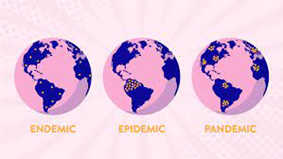 Covid-19 has taught us many new things over the past two years, and it has raised public understanding of the difference between an epidemic, pandemic and endemic. When there was a sudden surge of new cases of Covid-19 starting from Wuhan, China in 2020 as a typical Infectious Communicable Disease, we started hearing the word ‘Epidemic’, which is defined by the Centers for Disease Control and Prevention (CDC) as a sudden, unexpected increase in number of cases of a disease in a certain geographical area. An epidemic can be contagious or non-contagious, for example smallpox, polio or obesity, West Nile fever, smoking, etcetera.
Covid-19 has taught us many new things over the past two years, and it has raised public understanding of the difference between an epidemic, pandemic and endemic. When there was a sudden surge of new cases of Covid-19 starting from Wuhan, China in 2020 as a typical Infectious Communicable Disease, we started hearing the word ‘Epidemic’, which is defined by the Centers for Disease Control and Prevention (CDC) as a sudden, unexpected increase in number of cases of a disease in a certain geographical area. An epidemic can be contagious or non-contagious, for example smallpox, polio or obesity, West Nile fever, smoking, etcetera.
The difference in the state of an epidemic and pandemic is not in the severity of the disease but the extent to which it has spread. In a matter of weeks in the spring of 2020, we moved from the stage of ‘Epidemic’ to ‘Pandemic’ as positive cases of Covid-19 went sky high, with increased hospitalizations and the worrisome need for isolation and quarantine of sick people. The Centers for Disease Control and Prevention (CDC) declares a pandemic when the disease’s growth and spread are markedly exponential. Meaning that the number of cases grow at increasing rates each successive day, at times doubling or tripling, following an exponential pattern. A pandemic moves across international boundaries and sweeps across states, countries, and continents, making the health issue global.
Two years later presently, some scientists are optimistic and enthused as the number of hospitalizations and positive cases are going down and they are now using the term ’Endemic’ for Covid-19, encouraging local health bodies and state governments to ease off the non-medical interventions of prevention like wearing masks, maintaining social distance, frequent washing up, and increased medical intervention of vaccination and testing.
By definition ‘Endemic’ is a state when a disease may be consistently present but remains limited to a certain geographical region or season and the pattern of spread is predictable, allowing timely interventions to keep the disease under control. An example is Malaria in certain regions, especially during the monsoon season and summer in hot and humid tropical areas. Endemic does not mean less infectious or less severe cases, but instead, a more predictable and stable spread over time.
As far as Covid-19 is concerned, it has not reached an ‘Endemic’ stage yet but is moving towards it day by day as more and more people are getting vaccinated. The positive cases are going down, which shows that an ‘endemic’ stage may be round the corner now. However, all health professionals and researchers along with many scientists are being conservative still, as they see the transformation of Covid-19 from a pandemic into an endemic, cautioning everyone to maintain safe practices.
Many states across the United States including California, New Jersey, New York, Delaware and Connecticut are easing mask requirements for indoor dining, schools, colleges, and universities. This policy was adopted by Denmark a short while back and it resulted in making Denmark the top country in terms of the largest number of positive cases today. Let us not make the same mistake that Denmark made; let’s learn from it as a cautionary tale, and slowly ease into a pre-Covid way of life.
It is hoped that Omicron was the last big wave of Covid-19 and although there may be more variants, their spread will be well controlled and predictable, qualifying and maintaining the disease at an Endemic’ stage before long!

order modafinil 100mg online order modafinil generic buy modafinil cheap buy provigil for sale brand modafinil modafinil 200mg sale modafinil us
Your comment is awaiting moderation.